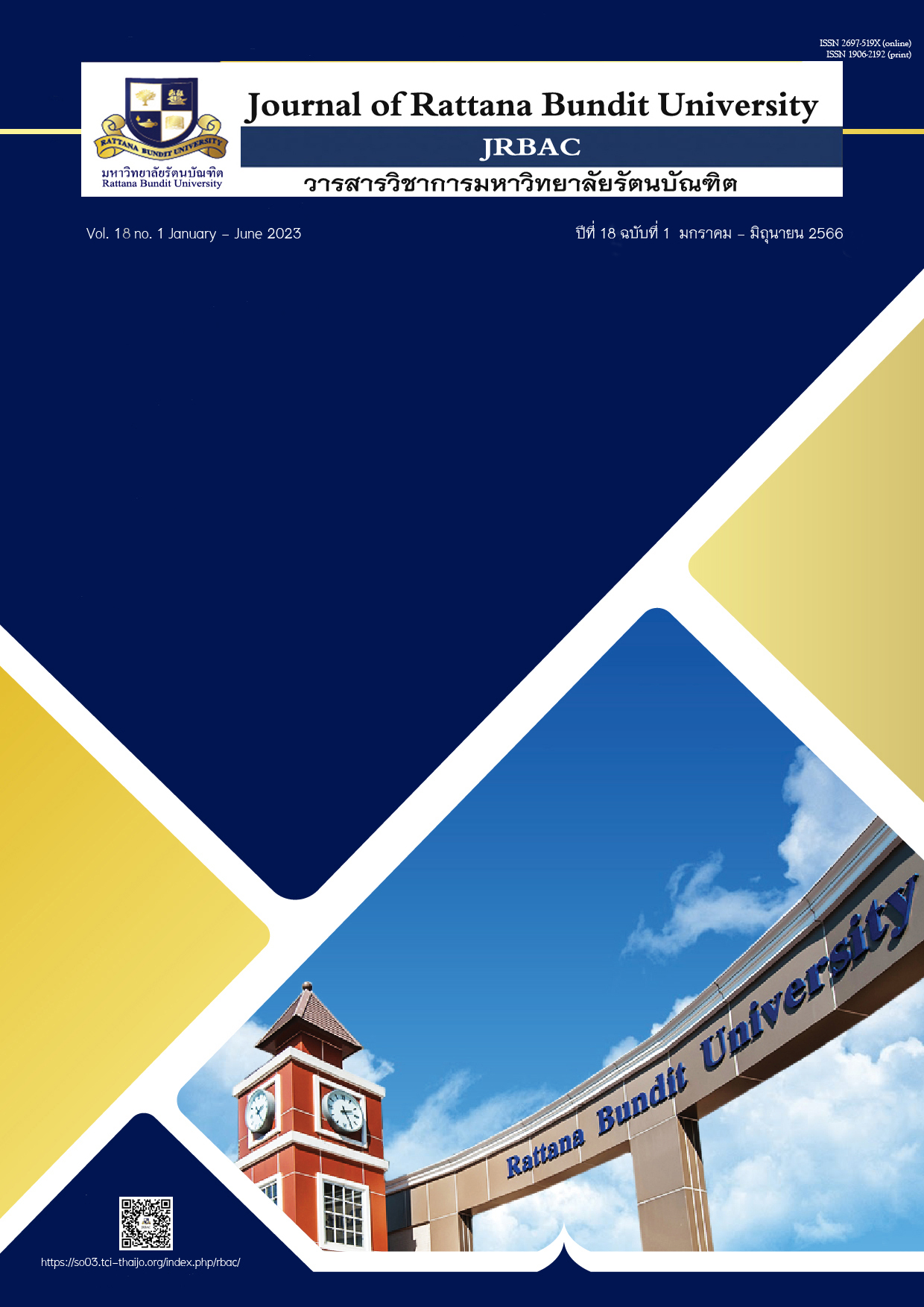Factors of Success of the Thai Spa Business
Main Article Content
Abstract
This article aims to present the success factors of the spa business in Thailand. In order to create an academic database for spa operators in Thailand, a literature review format based on relevant papers and research findings was employed, along with studies and research from information and websites on the Internet. In addition to medical services, Thailand has a high potential to provide health promotion and support services such as spas, Thai massages, beauty businesses, etc. Since 2004, the Thai government has supported companies in this field. The Office of the National Economic and Social Development Board and the Ministry of Public Health have established the vision of Thailand as a World Class Healthcare Destination by declaring the goal of turning the nation into an international health center. Currently, the government's policy is to develop the Thai spa industry as a leading destination for global health tourism (Thailand Wellness Tourism), to be the hub of treatment and health care (Medical and Wellness) in Asia, and to be recognized for health services of (World Class) caliber. According to the literature review, three main factors contribute to the success of the spa industry in Thailand: 1) service quality, 2) marketing strategies, and 3) management. The success elements for the Thai spa business include higher profits, a competitive advantage, customer loyalty, and high-end customers.
Article Details

This work is licensed under a Creative Commons Attribution-NonCommercial-NoDerivatives 4.0 International License.
References
กฎกระทรวง กำหนดบริการอื่นในกิจการสปา พ.ศ. 2560. (2560, เมษายน 28). ราชกิจจานุเบกษา, 134(47ก), 28-30.
กรมพัฒนาธุรกิจการค้า. (2561). คู่มือเกณฑ์มาตรฐานคุณภาพการบริหารจัดการธุรกิจสปา. https://www.dbd.go.th/more_news.php?cid=1155
กรมสนับสนุนบริการสุขภาพ. (2563). พระราชบัญญัติสถานประกอบการเพื่อสุขภาพ พ.ศ. 2559 และที่แก้ไขเพิ่มเติม (พิมพ์ครั้งที่ 2). สำนักงานกิจการโรงพิมพ์องค์การสงเคราะห์ทหารผ่านศึก.
กระทรวงสาธารณสุข กรมสนับสนุนบริการสุขภาพ. (2563). จำนวนสถานประกอบการสุขภาพสปาในประเทศไทยปี 2563. https://hss.moph.go.th/index2.php
กรุงเทพธุรกิจ. (2565). ธุรกิจสปา แนวโน้มเติบโต 17% ต่อปี หลังวิกฤติโควิด-19. https://www.bangkokbiznews.com/social/988560
ปุลวัชร ปิติไกรศร. (2560). คิดนอกกรอบ ตอบโจทย์เทรนด์ธุรกิจ Wellness Tourism. https://www.scbeic.com/th/detail/product/4010
พระราชบัญญัติสถานบริการ (ฉบับที่ 4) พ.ศ. 2546. (2547, มกราคม 12). ราชกิจจานุเบกษา, 121(6ก), 1-9.
มนต์ชัย วงษ์กิตติไกรวัล. (2561). ธุรกิจสปาไทยติด Top 5 ของเอเชีย แนะโรงแรมเพิ่มบริการรับเทรนด์. https://thestandard.co/thai-spa-top-5-asian-spa/
Alahmed, M. A. A. (2018). Identifying the determents of government e-service quality in the UAE. Electronic [Dissertations, United Arab Emirates University].
Bangkok Business (2022). Spa business tends to grown 17% per year after the crisis of COVID-19. https://www.bangkokbiznews.com/social/988560 (in Thai).
Charak, N.S. (2019). Role of spa resorts in promoting India as a preferred wellness tourism destination: A case of Himalayas. International Journal of Spa and Wellness, 2(1), 53-62.
Craig, V. (2019). The impacts of high-volume massage on spa therapists’ physical and mental wellness. International Journal of Spa and Wellness, 1(3), 218-227.
Department of Business Development. (2018). Handbook of quality standards for spa business management. https://www.dbd.go.th/more_news.php?cid=1155 (in Thai).
Department of Health Service Support. (2020). Health Establishment Act B.E. 2559 and its amendments (2nd ed.). Office of the Veterans Affairs Printing Organization. (in Thai).
Grand View Research.com. (2020). Spa market size, share & trends analysis report by service type (Hotel/resorts spa, destination spa, day/salon spa, medical spa, mineral spring spa), by region, and segment forecasts, 2021-2028. https://www.grandviewresearch.com/industry-analysis/spa-market
Guillet, B. D., & Kucukusta, D. (2019). Analyzing attributes of the spa service experience: Perceptions of spa-goers traveling to Hong Kong. Journal of China Tourism Research, 15(1), 66-83.
Huang, Y. C., Chen, C. C. B., & Gao, M. J. (2019). Customer experience, well-being, and loyalty in the spa hotel context: Integrating the top-down & bottom-up theories of well-being. Journal of Travel & Tourism Marketing, 36(5), 595-611.
Huh, C., Lee, M. J., & Lee, S. (2019). A profile of spa-goers in the US luxury hotels and resorts: A posteriori market segmentation approach. Journal of Hospitality Marketing & Management, 28(8), 1032-1052.
International Spa Association: ISPA Europe. (2010). Types of spas. http://experienceispa.com/resources/spagoers
Koskinen, V., & Wilska, T. A. (2018). Identifying and understanding spa tourists’ wellness attitudes. Scandinavian Journal of Hospitality and Tourism, 19(2), 1-19.
Lam, L.Y.J., & Gao, Y. (2020). Hong Kong millennials’ intention to visit local hotels spas. Journal of China Tourism Research, 16(4), 510-526.
Lee, D.H. (2019). The impact of exhibition service quality on general attendees’ satisfaction through distinct mediating roles of perceived value. Asia Pacific Journal of Marketing and Logistics, 32(3), 793-816.
Ministerial Regulations prescribing other services in the spa business B.E. 2560. (2017, April 28). Royal Gazette, 134(47a), 28-30. (in Thai).
Ministry of Public Health Department of Health Service Support. (2020). Number of health spa establishments in Thailand year 2020. https://hss.moph.go.th/index2.php (in Thai).
Pandey, B., Ritthichairoek, A., & Puntien, S. (2020). Examination of marketing mix factors in Chinese tourists' demand for spa service in middle-sized Bangkok Hotel. In International Academic Conference Global Goal, Local Actions: Looking Back and Moving Forward 2020, 1(11), 103-111.
Parasuraman, A., Zeithaml, V. A., & Berry, L. L. (1988). SERVQUAL: A multiple-item scale for measuring consumer perceptions of service quality. Journal of Marketing, 64(Spring), 12-40.
Pitikraisorn, P. (2017). Think outside the box to meet business trends in wellness tourism. https://www.scbeic.com/th/detail/product/4010 (in Thai).
Service Place Act (No. 4) B.E. 2546. (2547, January 12). Government Gazette, 121(6a), 1-9. (in Thai).
Sevilmi, A., Erdoan, A., & Irin, E.F. (2019). Innovative delivery systems loaded with plant bioactive ingredients: Formulation approaches and applications. https://www.mdpi.com/2223-7747/10/6/1238
Silva, M. A., D. S., Costa, R. A., & Moreira, A. C. (2018). The influence of travel agents and tour operators' perspectives on a tourism destination: The case of Portuguese intermediaries on Brazil's image. Journal of Hospitality and Tourism Management, 34, 93-104.
Suttikun, C., Hyo Jung Chang, Hamilton Bicksler. (2017). A qualitative exploration of day spa therapists' work motivations and job satisfaction. Journal of Hospitality and Tourism Management, 34, 1-10.
Thailand Holistic Health. (2019). Spa business and health promotion tourism. https://www.thailandholistic.com/spa-business-and-tour-health-promote/
Timberlake, J. (2020). Spa and wellness trends for 2020. https://eminenceorganics.com/ca/blog/2020/01/20/spa-and-wellness-trends-2020
UKEssays. (2018). Spa and wellness trends in tourism. https://www.ukessays.com/essays/tourism/the-impact-of-the-spa.php?vref=1
Whitley, A. (2019). Signature stone crop body treatment for spa professionals. https://eminenceorganics.com/ca/blog/2019/06/17/signature-stone-crop-body-treatment-spa-professionals
Wisnom, M., & Gallagher, K. (2018). Quality of work life in the resort spa industry. International Journal of Spa and Wellness, 1(3), 159-177.
Wongkittikraiwan, M. (2018). Thai spa business ranked among the top 5 in Asia, recommending hotels to increase service to catch the trend. https://thestandard.co/thai-spa-top-5-asian-spa/ (in Thai).


